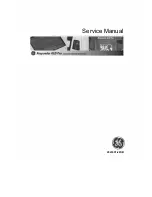
2-50 TSP Programming Fundamentals
Series 2600 System SourceMeters Reference Manual
2600S-901-01 Rev. A / May 2006
Return to
The following command returns a catalog listing of the factory scripts stored in the
Series 2600:
script.factory.catalog
()
Example:
Retrieve the catalog listing for factory scripts:
for name in script.factory.catalog() do
print (name)
end
The following function retrieves a script listing. The script chunk is returned, along
with the shell keywords (
loadscript
or
loadandrunscript
, and
endscript
):
script.factory.scripts.name.list()
where:
name
is the name of the factory script.
Example:
Retrieve the script listing for a factory script named “sourceMeasureDC”:
factoryscriptlist = script.factory.scripts.sourceMeasureDC()
print (factoryscriptlist)
Differences: remote vs. local state
The Series 2600 can be in either the local state or the remote state. When in the
local state (REM annunciator off), the instrument is operated using the front panel
controls. When in the remote state (REM annunciator on), instrument operation is
being controlled by the PC. When the instrument is powered-on, it will be in the
local state.
Remote state
The following actions will place the instrument in the remote state:
• Sending a command from the PC to the instrument.
• Running a script (FACTORY or USER test) from the front panel. After the
test is completed, the instrument will return to the local mode.
• Opening communications between the instrument and Test Script Builder.
While in the remote state, front panel controls are disabled. However, the LOCAL
key will be active if it has not been locked out. When an interactive script is running,
the front panel controls will be active to allow the operator to input parameter val-
ues.
Summary of Contents for SourceMeter 2600 Series
Page 575: ...AppendixF DisplayCharacterCodes Appendix F topics Introduction page F 2...
Page 592: ......
Page 593: ......
















































